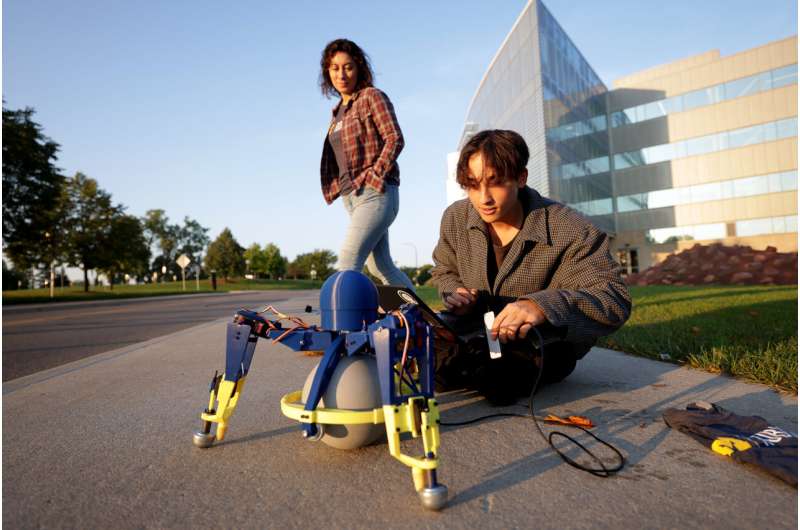March 16, 2024 feature
This article has been reviewed according to Science X's editorial process and policies. Editors have highlighted the following attributes while ensuring the content's credibility:
fact-checked
preprint
trusted source
proofread
A skating, tri-pedal robot capable of highly stable locomotion

Researchers at University of Michigan recently developed SKOOTR, a tri-pedal skating robot that can efficiently move around in its surroundings without repeatedly flipping over. This robot, introduced in a paper posted to the preprint server arXiv, was found to be more stable than other three-legged robots, which often exhibit poor stability due to the lack of a fourth leg to better balance their body.
"A major focus of my lab is designing open-source robotic platforms that are frequently inspired by biology," Talia Y. Moore, co-author of the paper, told Tech Xplore. "I came up with this idea as I was rolling around on my office chair between groups of students. I realized that the passively rolling office chair could easily spin in any direction, and I could use my legs to perform a variety of maneuvers while staying remarkably stable. I realized that this omnidirectional maneuverability is similar to how brittle stars change directions while swimming."
The key idea that drove this recent study was combining the maneuverability of a ball-bot with the stability and versatility of a legged robot. Using a radially symmetric configuration, like a sea-star or spider web, would allow the robot to easily change direction, but would require discovering new forms of locomotion that result from pushing and rolling at the same time. Moore pitched this idea to her undergraduate students and one of them, Adam Hung, decided to explore it in further.
"Adam Hung went home for the summer and built the robot using his 3D printer at home," Moore said. "One of my Ph.D. students, Challen Enninful Adu, also helped with the dynamics and controls. We met over zoom every week that summer and had a fully functional robot by the start of the fall semester."
SKOOTR, the robot developed by Moore and her colleagues, is made up of a large sphere situated in the middle of three robotic legs. On top of the passively rotating sphere is a central hub that holds all the electronics supporting the robot's functioning, with three legs sprouting out of it. Each of the legs has two joints governing their flexion and extension, and a hybrid contact mode at its tip.
"We use a servo to switch between a passively rolling caster or a grippy rubber foot," Moore explained. "The rubber foot provides friction so that it can use a leg to push against the ground, while the rolling caster allows other legs to maintain their position while rolling along. The central sphere can easily pop out and be replaced for different purposes."
The SKOOTR robot is customizable, as the large sphere at the center of the body can be easily replaced to meet the specific needs of users. For instance, a hollow sphere could serve as a container where objects can be stored, so that the robot can deliver them to target locations. In addition, heavier or lighter spheres could partly influence the robot's efficiency, speed of locomotion, and stability.
"Due to this combination of the central sphere and multiple legs, SKOOTR is incredibly stable," Moore said. "We have been doing lots of experiments with SKOOTR and it's basically impossible to flip it over while it is operating. It is also capable of much more than you would think from just looking at the 'skooting' gait. By lifting its sphere up with its legs, SKOOTR can overcome obstacles that would be difficult for other rolling robots. SKOOTR can even climb stairs."
In laboratory experiments carried out by Moore and her students, the SKOOTR robot performed remarkably well, exhibiting greater stability than other three-legged robots with more conventional designs. In the future, the robot could be introduced and tested in real-world settings, to explore its ability to tackle different tasks.
"We now plan to learn more about the benefits of radial symmetry in robots, discover novel forms of locomotion, and build open-source robots that can be easily used by other researchers," Moore added. "We already have a neuroscientist collaborator who is interested in using SKOOTR to better understand octopuses."
More information: Adam Joshua Hung et al, SKOOTR: A SKating, Omni-Oriented, Tripedal Robot, arXiv (2024). DOI: 10.48550/arxiv.2402.04374
© 2024 Science X Network


















